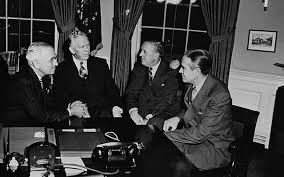Post-WWII monetary systems marked the final chapter in silver’s long history as a monetary metal. With the establishment of the Bretton Woods Agreement in 1944, global finance shifted to a gold-backed U.S. dollar, sidelining silver entirely from international monetary policy. Unlike previous centuries, when silver played a crucial role in trade and currency, the new system relied solely on gold and fiat currencies, making silver obsolete in official reserves. This shift not only accelerated silver’s decline as money but also redirected its importance toward industrial applications and investment markets. The post-war era cemented silver’s transformation from a foundation of currency to a commodity-driven asset in the modern economy.

1. The Bretton Woods Agreement (1944): A New Gold-Based System
- The Need for a Stable Post-War Financial System
- After the economic devastation of World War II, global leaders sought to create a stable, predictable monetary system to facilitate trade and reconstruction.
- The interwar period had seen currency instability, competitive devaluations, and economic crises, which world powers wanted to prevent in the new system.
- The U.S. Dollar Becomes the World’s Reserve Currency
- At the Bretton Woods Conference (July 1944), 44 nations agreed to peg their currencies to the U.S. dollar, which in turn would be backed by gold at a fixed rate of $35 per ounce.
- This effectively made the U.S. dollar the world’s primary reserve currency, replacing the gold and silver-based systems of the past.
- Silver was completely omitted from this new structure, marking its final removal from the global monetary order.
- The Establishment of New Financial Institutions
- The International Monetary Fund (IMF) and the World Bank were created to oversee the new system, reinforcing the dominance of gold and the dollar in global finance.
- With international exchange rates tied to gold via the U.S. dollar, silver lost any remaining monetary role it had left.
2. The Consequences of Silver’s Removal from the Monetary System
- Silver No Longer Backed Major Currencies
- After centuries as a primary monetary metal, silver was now officially excluded from the global financial framework.
- Countries no longer needed silver reserves to support their currencies, further decreasing demand for silver in monetary policy.
- Silver’s Shift Toward Industrial and Investment Uses
- With its monetary role eliminated, silver increasingly became a commodity used for industrial applications such as electronics, photography, and medicine.
- However, silver remained a store of value and continued to be bought by investors as a hedge against inflation.
- The End of Silver Coinage in Global Currencies
- In the decades following Bretton Woods, most governments phased out silver coins from circulation:
- The United States removed silver from most coinage in 1965, replacing it with base metals.
- Other nations, including Canada, the UK, and European countries, followed suit in the 1960s and 1970s.
- In the decades following Bretton Woods, most governments phased out silver coins from circulation:
3. The Final Nail in the Coffin: The Collapse of the Gold Standard (1971)
- The Nixon Shock and the End of Bretton Woods
- In 1971, U.S. President Richard Nixon ended the gold convertibility of the U.S. dollar, effectively dismantling the Bretton Woods system.
- This created a new era of fiat currencies, where money was no longer backed by gold or silver, but by government policy and economic confidence.
- Silver Becomes a Purely Industrial and Investment Metal
- With both gold and silver removed from monetary backing, silver’s role in the economy became almost entirely industrial.
- Despite no longer being a currency standard, silver remained a valuable investment asset, often compared to gold as a “safe-haven” commodity.
Conclusion: The Complete Removal of Silver from Global Finance
The Bretton Woods Agreement of 1944 marked the final stage of silver’s decline as a monetary metal, replacing it with a gold-backed U.S. dollar as the foundation of the global economy. While silver had already lost its primary role in the late 19th and early 20th centuries, its complete omission from the post-WWII financial system cemented its transition to an industrial and investment commodity. By the time the gold standard collapsed in 1971, silver was no longer part of any major monetary system, ending its centuries-long legacy as a foundation of global trade and finance.
